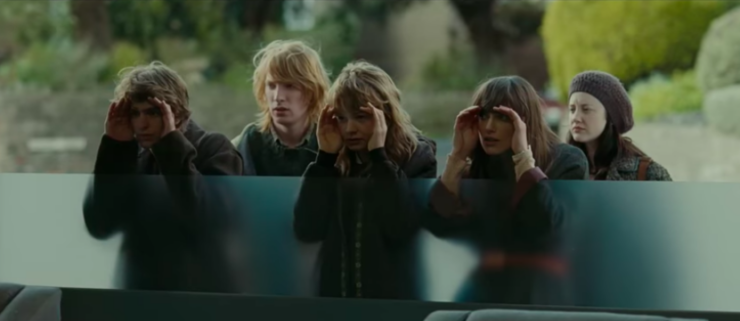“This is the Way.”
I have a little bit of a problem with how the producers of The Mandalorian handle this core piece of dogma. I get what they’re doing; all through the series, the titular Mandalorian, Din Djarin (Pedro Pascal), is placed into situations where he is required to act against his bedrock faith, and as a result question its tenets. Fate has a way of undermining his hardcore adherence, as in a recent episode when his attempt at a rite of absolution in the “Living Waters” of his ravaged home world is disrupted by an unexpected plunge beneath the surface.
But if the producers want us to approach Mando’s devotion with some form of skepticism, they also want us to grant him a degree of respect. In the same episode, Din tells the embittered former Regent of Mandalore, Bo-Katan (Katee Sackhoff), “Without the Creed, what are we? What do we stand for? Our people are scattered like stars in the galaxy—the Creed is how we survived.” Credit Pascal, there is nothing in his soft, thoughtful performance that bespeaks blind obedience. We are asked not to doubt the importance of the Creed in Din’s life; it holds his universe together, gives him purpose.
It is not impossible to hold two diametrically opposed opinions about the philosophies others employ to make their way through this koo-koo, nutty thing called life. I suspect we’re mostly inclined to give someone’s approach, however exotic, the benefit of the doubt, mainly because we need that leeway ourselves. Chaos may be the prime operating model of the cosmos, but for better or worse we need some perception of order, some concept of stability to allow us to tackle each day. Some of that perception gets handed to us, some we develop on our own. But we accept our view of the Established Order of Things as uncompromising fact. This is how the world works, this is our place in it, done.
Until there comes the time when our faith is undercut.
(Have a care—spoilers for Never Let Me Go are ahead.)
Toward the end of the brilliant, devastating film Never Let Me Go (2010), two clones bred by the government to be organ donors, Kathy (Carey Mulligan) and Tommy (Andrew Garfield) approach Madame Marie-Claude (Nathalie Richard), a mysterious woman who in the past collected the art of the young residents of Hailsham, a private school for clones. Kathy and Tommy, now adults in their late twenties, have been living with a rumor they heard a decade prior: That clones who have fallen in love can receive a deferment from being harvested. Tommy, suspecting that the clones’ art was collected as a kind of psychic check digit, a way to confirm the validity of their emotions, has brought Madame his drawings of fantastical animals, so that he may be evaluated and granted more time with Kathy.
But Madame and her partner, Miss Emily (Charlotte Rampling)—the woman who once ran Hailsham—disabuse the clones of the notion. The collected art was not to look into the clones’ souls, but to prove to others that clones had souls at all. It was not an act instituted for the clones’ sake, but to make a political point: That the clones were owed at least the benefit of growing and developing as humans before being stripped of parts.
It turns out, though, that the crusade that compelled Madame and Miss Emily to found Hailsham is a failed one. The cloning program, established in this alt-history not long after WWII, is too well-entrenched—with people living well past 100—for recipients to entertain the notion that their sentient organ banks might be deserving the dignity of thriving as regular humans. Better to tuck the whole notion into some darkened corner, and not entertain the idea that clones could think, feel, or love.
On their way home from the meeting, Tommy asks Kathy to pull the car over. He walks out into a darkened field, and screams his grief.
Tommy’s wordless anguish would be overwhelming enough, but director Mark Romanek, taking his cue from the original novel by Kazuo Ishiguro, uses it to contrast with our first moments with Tommy, when we see him as a child prone to rages over minor slights and frustrations. To watch him devolve back—with almost the same choreography as we saw when he was a kid—is to examine a person coming to the realization that, from start to present, he has lived within a delusion.
There are many lenses through which one can read Never Let Me Go, which tracks the clones’ experiences from childhood to adulthood. It could be a critique of classism or racism. However, the intervention of another so-called Guardian, Miss Lucy (Sally Hawkins), who tries to warn her young charges about the reality of their situation, steers the film’s themes in another direction. After all, for however noble Madame’s and Miss Emily’s campaign might have been, it doesn’t seek to subvert a well-ensconced system (notably, it’s Miss Emily who eventually fires Miss Lucy before she can get too far in educating the clones). It’s akin to Temple Grandin’s work to assure that cattle do not suffer unduly on their way to slaughter. It’s definitely humane—and admirable—but we still get our hamburgers.
But the reason Never Let Me Go rips our hearts out is that this is not the story of Madame or Miss Emily or Miss Lucy, but one seen through the eyes of Kathy, and Tommy, and a third Hailsham student, Ruth (Keira Knightley), who maintains a tenuous friendship with Kathy and eventually becomes Tommy’s lover. While they go blithely about their lives, we the audience get to see all too well that something is off with their upbringing: There’s the Eighties-tech bracelets that they have to scan upon entering or leaving a building; and the neat rows of tiny pill cups that are dispensed to each student at the start of each day. And later on, when we see one donor with a bandaged eye or Ruth struggling with her walker down a corridor, we can’t help but be disturbed by the casualness with which all the clones treat their progression toward—as the characters so delicately put it—“completion.”
It’s Kathy who becomes our locus for the tension between what the characters perceive and what we can see—she narrates the film and eventually elects to become a Carer, a clone who tends to the needs, both physical and emotional, of her fellow clones once they begin their donations. She prides herself on being good at her job (in the novel, she’s so well-regarded that she’s given the privilege of deciding who she will attend to) and presides over the harvesting of her charges without ever once questioning a system where the beneficiaries cannot bear the burden of seeing to the comfort and happiness of those to whom they owe their extended lifespans.
Buy the Book


The Mimicking of Known Successes
But even if the words aren’t spoken, it’s clear that questions—if only subliminally—haunt the clones. It shows in that rumored possibility of deferral, and in Kathy leafing through a stack of porn magazines, thinking that her sexual urges must mean that her original template was an adult model or prostitute. There’s a war going on within each organ donor, pitting all they’ve ever known against an innate sense that things don’t quite track. (As an aside, one of the more unfortunate alterations from book to screen was to make Kathy a practical spinster, as opposed to the sexually active character she is in the novel. Maybe Romanek wanted to cast Kathy’s situation in sharper relief vis-à-vis Ruth and Tommy, or maybe everyone just feared the MPA wouldn’t look kindly on teenagers being too profligate with their bodies. Either way, it martyrs Kathy in a way that wasn’t necessary, and deprives us of an additional glimpse into how the clones perceive their place in this world.)
Jean-Luc Godard said, “The cinema is truth 24 times per second.” That’s a bit too broad and optimistic a definition, but the camera does let us see what the characters cannot. In some less-thoughtfully crafted films, that can be an annoyance (how many films have you sat through where you wanted to scream at screen, “Jeezus Kee-ryst, can’t you see that the friendly barista is actually an axe murderer?”), but Romanek never falls into that trap, maintaining an idyllic tone and sketching the world carefully through the characters’ eyes, even as we can see beyond their naïveté. (Ishiguro carries it a step further, making it clear that as the characters age, they steadfastly fail to wonder why their environs have become so decrepit. While the film’s settings hint at a similar progression of decay, the beautiful cinematography tends to counteract the impact of the production design.)
In some ways, Never Let Me Go is a horror film, where the horror is a realization that our protagonists—and the world overall—are trapped in a system that has so been accepted that it cannot be subverted, and can barely be perceived. The darkness of that realization, contrasted with the quiet, beautiful mise-en-scène—and superb performances by Mulligan, Knightly, and Garfield—allow the film to be, not a dagger to our hearts, but a scalpel, where each cut is exquisitely deployed, and deeply felt. With a voice barely louder than a whisper, it demolishes us, and leaves us to ponder the wisdom of unquestioningly accepting the world as it is.
* * *
For some odd reason, Never Let Me Go has remained undeservedly mired in obscurity. Maybe its subdued tone prevented it from grabbing the attention it justly deserves, or maybe too many people confused it with movies like Michael Bay’s bombastic The Island (2005), or the supremely silly Parts: The Clonus Horror (1979). Have you seen it? Did it touch you as profoundly as it did me? Or maybe there’s another film that moved you in ways you weren’t aware of until the final fade. I’d like to hear your thoughts, so please take advantage of the comments section below. Remember though, we’re all human here. Let’s respect each other’s view of things.
Dan Persons has been knocking about the genre media beat for, oh, a good handful of years, now. He’s presently house critic for the radio show Hour of the Wolf on WBAI 99.5FM in New York, and previously was editor of Cinefantastique and Animefantastique, as well as producer of news updates for The Monster Channel. He is also founder of Anime Philadelphia, a program to encourage theatrical screenings of Japanese animation. And you should taste his One Alarm Chili! Wow!










